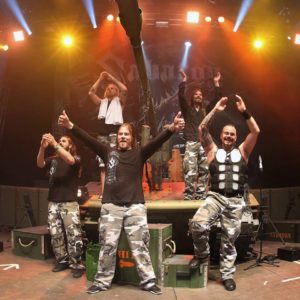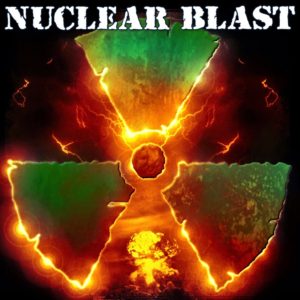Sabaton is:
Joakim Brodén: vocals and keyboards
Pär Sundström: bass and backing vocals
Chris Rörland: guitar and backing vocals
Thobbe Englund: guitar and backing vocals (recently replaced by Tommy Johansson )
Hannes van Dahl: drums
Rob Halford: guest vocals on “All Guns Blazing“
Recorded April – May 2016, Abyss Studios, Sweden
Peter Tägtgren: Producer
Sabaton’s eighth album “The Last Stand” was recently released on the Nuclear Blast record label and sets a new standard for Progressive Power Metal. This is another of Sabaton’s signature, history based concept albums and does not disappoint. Intelligent, well thought out and brilliantly written, “The Last Stand” is a formidable album following the critic and fan acclaimed “Heroes” in 2014. This is growth in a very positive direction.
This album has been highly anticipated by a number of our staff members and I am truly honored to be the one reviewing this masterpiece. I find the concept of military valor in the face of overwhelming odds in these days of artificial offense, misconstrued definitions of courage and political correctness running rampant absolutely refreshing and needed. In the words of Winston Churchill, “Those that fail to learn from history are doomed to repeat it”. If this is to be believed, the converse also must be true and this is the point that I think Sabaton is making so masterfully in “The Last Stand”. Reverent and respectful in context; beautiful and poignant in its execution. While I have loved everything that Sabaton has done in the past, there is something in “The Last Stand” that struck a nerve and a heart string that I have not felt so intensely with any prior release. When trying to nail down why this is the case I spoke to the other Veterans on the MN staff and we universally were struck with the same aura. Maybe it the ingrained sense of honor, pride, camaraderie and being part of something bigger than ourselves in the interest of our country and fellow man drilled into us while serving. Maybe it is our innate sense of patriotism the Service further tattooed onto our souls and assures that we always have brothers and sisters in arms. Maybe something else, but we were all moved in precisely the same ways which leads me to believe that it is something more than mere coincidence. Honestly, I find myself moved to tears throughout this release. As in everyday life, adversity grows honor to self which is contagious and leads to respect and honor to and from others we choose to associate with. If we learn this as a society we self perpetuate to our children and grandchildren to create the potential to a Utopia of sorts. Maybe I am off base here, but is what I am taking away from “The Last Stand” after listening to it innumerable times.
Musically, “The Last Stand” definitely has the unmistakable sound that Sabaton has developed over the last seven albums. Accented, Viking Metal vocals on top of some of the sickest keyboard and guitar accompaniment out there. Booming bass lines and blasting drums, of course, hit very hard and keep the time signatures nailed down to absolute perfectioin. One notable difference in this album from prior releases is that the music is pulled back a bit to allow the historically significant lyrics to shine through. This is not to say that this album is any less or more of anything in particular; simply a slight redirection of what already makes Sabaton such a stand out band in the Metal world. We are also introduced to their first song in a major key and bagpipes with “Blood of Bannockburn”, my favorite song on this incredible release. Another notale standout is “Shiroyama”. This is the type of song that is so catchy and memorable that it is likely to get stuck in your head for days at a time. Even a couple of us that lean more into the extremes of our beloved genre like it. Sabaton proves to, again, have something for everyone.
To say that I love this CD would be an understatement. It has quickly become one of my favorite releases of 2016 and am sure that it will tide me over until Sabaton drops something in the future to accompany the place it has taken residence in my heart. In an effort to clarify the significance of the historical events that Sabaton has chosen to highlight, I did some research on Wikipedia or included what was released with single releases from Sabaton over the course of the few months. This list is in track order as a reference.
Sparta: Battle of Thermopylae. 300 Spartans under King Leonidas and other Greek allies hold back the Persians led by Xerxes I for three days but are defeated. The indecisive battle of Artemision between the Greek and Persian fleets of Xerxes I. The Greeks withdraw to Salamis. The battle of Thermopylae was the first between the Persians and Greeks during the Persian invasion of 480-479 BC. The Greek force was very small but was determined to make a stand against the huge Persian army
Last Dying Breath: Major Draguitin Gavrilović, commander of the 2nd battalion of the 10th Cadre Regiment, a detachment of of Belgrade gendarmerie and 340 volunteers from Syrmia, dramatically ordered his troops to defend Belgrade on October 7, 1915, against the Austro-Hungarian and German attack during World War I. When attacked across the rivers with superior artillery, the Serbians trapped the invaders against the Danube after suffering huge losses. As enemy reinforcements arrived, the Serbian situation worsened. Covering their uniforms and weapons with flowers, Major Gavrilović addressed his troops just before their final charge to the death saying:
“Soldiers, exactly at three o’clock, the enemy is to be crushed by your fierce charge, destroyed by your grenades and bayonets. The honor of Belgrade, our capital, must not be stained. Soldiers! Heroes! The supreme command has erased our regiment from its records. Our regiment has been sacrificed for the honor of Belgrade and the Fatherland. Therefore, you no longer need to worry about your lives: they no longer exist. So, forward to glory! For the King and the Fatherland! Long live the King, Long live Belgrade!”
While failing to destroy the Austro-Hungarian bridgehead, this desperate charge among many others by the Serbians earned deep respect from the invaders who suffered about 10,000 casualties and later erected a statue honoring the fallen on both sides.
Blood of Bannockburn: In 1314, nine years after the execution of William Wallace, the Scottish laid siege upon Stirling Castle and an agreement was made that if it had not been relieved by mid-summer the English would surrender the castle to the Scottish. The English could of course not ignore that challenge, and sent a formidable force north towards Stirling to break the siege and relieve the troops inside. In the end Robert the Bruce and the Scottish defeated the English under Edward II’s command with a force half the size and not nearly as well equipped of what the English had at their disposal.
Diary of an Unknown Soldier: The Meuse-Argonne Offensive, commanded by General John Pershing, was fought for forty seven days from September 26,1918 until the Armistice on November 11, 1918 as part of the final Allied offensive of World War I as part of the Hundred Days Offensive that ultimately put an end to the war. Stretching along the entire Western front and involving some 1.2 million American soldiers, it was the largest offensive in U.S. military history. Once over, 26,277 lay dead along with 95,786 injured making it the bloodiest operation of World War I and for the American Expeditionary Force (AEF).
The Lost Battalion: The Lost Battalion’ is the name given to nine companies of the United States’ 77th Division during the battle of the Argonne in 1918. Even though these 550-575 brave men were completely surrounded by the German Army and subjected to friendly artillery fire, they kept on fighting for a week until they were relieved. Of the over 500-plus soldiers who entered the Argonne Forest, only 194 walked out unscathed. The rest were killed, missing, captured, or wounded.
Rorke’s Drift: The Battle of Rorke’s Drift, also known as the Defense of Rorke’s Drift, was a battle in the Anglo-Zulu War fought from January 22, 1879 to January 23, 1879. Under the command of Lietenant John Chard of the Royal Engineers and Lieutenant Bonville Bromhead, a mere 150 British and colonial troops successfully defended their garrison against three to four thousand fierce Zulu warriors. Eleven Victoria Crosses were awarded to these courageous men among many other decorations and honors as a result.
The Last Stand: After losing favor in France and defecting to the enemy, the Constable of France, the Duc de Bourbon was put in charge of The Habsburg army, composed of Imperial and Spanish troops. Once morale had been denigrated to the point of mutiny by the Emperor’s refusal to pay the troops, Bourbon decided to attack Rome in an effort to loot the capital of Christianity. Being almost defenseless, the Pope ordered citizens to take up arms against the invaders. Only about 500 obeyed and were quickly dealt with by the invaders. In a grave yard just outside of St. Peter’s Basilica, the Swiss Guard, headed by Captain Kaspar Röist made their stand but were summarily slaughtered, leaving only about forty survivors who were then able to repel the Spanish troops pursing the Pope’s entourage.
Hill 3234: After negotiations to open the road from Gardez to Khost near the Pakistani between the mujahideen and the Soviet 40th Army under the command of General Boris Gromov broke down, Operation Magistral began in November 1987. After being cut off for months by Jalaluddin Haqqani led troops, air resupply was unsustainable. Knowing that a direct attack would be suicidal against the well fortified rebels, the Soviets set up a farce leading to the mujahideen warriors showing their locations. Against overwhelming force, 200 to 250 mujahideen warriors held off the Soviet assault from January 7th through the next day before being decimated and pushed back, allowing Russian supplies to begin moving again.
Shiroyama: It’s the nature of time and history that the old ways must give in to the new ways and the modern age. The battle of Shiroyama in 1877 marks the end of an era and is the last stand of the legendary Samurai. Led by Saigo Takamori, the Samurai was down to 500 warriors at the end of the rebellion when they made their last stand on Mount Shiroyama. At the end of the battle there were only 40 samurai left. They drew their swords and plunged downhill toward the enemy positions until the last of them was mowed down.
Winged Hussars: The Polish Hussars also known as Winged Hussars were 16th and 18th century Polish-Lithuanian Commonwealth elite cavalrymen.. During the Battle of Vienna on the 11th and 12th of September 1683 after the Ottoman Empire had laid siege on the city for over two months, a first time alliance of the Polish Hussars and the Holy Roman Empire took place to fight back the oncoming Turks. The combined forces won a decisive victory and is said to be the turning point in the 300 year Ottoman-Habsbrug struggle and known as the largest cavalry charge in known history.
The Last Battle: The Battle for Itter Castle, one of the final battles in the European Theater during World War II took place on May 5th, 1945 in the Austrian North Tyrol village of Itter. Under the command of John C. “Jack” Lee, Jr., of the 23rd Tank Battalion of the 12th Armored Division of the US XXI Corps, a ragtag group of Wehrmacht soldiers and recently freed French dignitaries, including a former prime minister, general and a tennis star defended Castle Itter against the attacking forces of the 17th SS Panzergrenadier Division until the American 142nd Infantry Regiment of the 36th Division of XXI Corps arrived. The Battle for Itter Castle is said to be the strangest battle of WWII.
Bonus Tracks include:
“Camouflage (Stan Ridgway Cover)”, making reference to Vietnam
“All Guns Blazing (Judas Priest Cover)”
“Afraid To Shoot Strangers (Iron Maiden Cover)”
More information on Sabaton can be found at: Web Facebook Nuclear Blast















